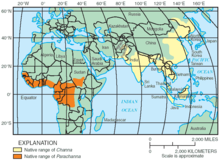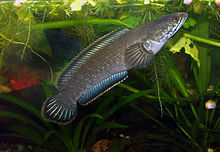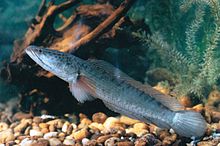Snakehead fish
| Snakehead fish | ||||||||||||
|---|---|---|---|---|---|---|---|---|---|---|---|---|

Eye spot snakehead fish ( Channa pleurophthalma ) |
||||||||||||
| Systematics | ||||||||||||
|
||||||||||||
| Scientific name | ||||||||||||
| Channidae | ||||||||||||
| Bleeker , 1860 |
The snakehead fish (Channidae, Syn . Ophicephalidae) are a family of predatory fish that inhabit three recent genera and around 50 species of fresh waters in tropical Africa, as well as South Asia and East Asia . They are slim fish that feed on aquatic insects, mollusks and fish. In Asia and Africa, snakeheads are bred as food fish in aquaculture .
features
Snakehead fish have a massive, cylindrical and elongated body with long dorsal and anal fin. They are 15 centimeters to 1.83 meters long and have round or comb scales . Ventral fins are usually present and are supported by six fin rays. The pelvic fins lie behind the pectoral fins. In some Channa species they may be missing ( C. asiatica , C. bleheri , C. burmanica , C. orientalis ). Originally the species without ventral fins were listed as Channa , Scopoli, 1777 , the species with ventral fins as Ophicephalus , Bloch, 1793 . However, the species without ventral fins do not form a monophyletic group. The characteristic was created at least three times independently of one another. The caudal fin of all snakehead fish is rounded. All fins are spikeless. The head, which appears to be snake-like because of the large mouth and the large scales, is somewhat flattened, the lower jaw protrudes slightly. The outer nostrils are often elongated like a tube. A suprabranchial organ in the gill cavity, which consists of a richly folded and well-perfused epithelium , enables them to breathe air. The first plate of the suprabranchial organ is formed by the epibranchial of the first branchial arch , while the second is a widening of the hyomandibular . The swim bladder is long and extends to the tail fin stalk. Snakehead fish are Physoclists , so they have a closed swim bladder.
distribution
Snakehead fish are found in tropical Africa and in South, Southeast and East Asia. The distribution area in Africa begins in the west in Senegal and then extends through all of West Africa south of the Sahel through Cameroon and the Central African Republic to South Sudan . Snakehead fish are also found in the western and central Congo Basin .
In South Asia, the range begins with the river basin of the Indus and then extends over India , Southeast Asia , including Sumatra , Kalimantan and Java . Snakehead fish did not originally appear beyond the Wallace Line . In East Asia, snakeheads are found in eastern China, Korea , the Amur river basin and Lake Chanka .
Meaning as a neozoon
In Madagascar , Sulawesi , the Philippines , Taiwan , Japan , in the Central Asian rivers Amu Darya , Syr Darya , Qashqadaryo and Talas , in Hawaii and in Florida and other states along the Atlantic coast of the United States they were exposed by the people and have become stable, to reproducing populations educated. In some of these areas, the snakehead fish have become a threat to the local fish fauna.
Reproduction
Basically, snakehead fish are monogamous . Beginning with sexual maturity, pairs are formed that stay together for the whole of their lives for the purpose of shared brood care. In snakehead fish there are free-spawning and mouth-brooding species. Especially the smaller snakehead fish, also called dwarf snakeheads, are almost without exception mouthbrooders. In contrast, there is no known species larger than 40 cm that is not freely spawning.
The actual spawning act is similar to that of the related labyrinth fish . When a pair has found each other and the male has found a spawning site, mock matings take place in which the male wraps around the female until the release of the sex products is synchronized. In free-spawning species, the egg is filled with an oil stain that drives it to the surface of the water. In mouth-brooding species, the male takes the eggs into its mouth.
The males almost exclusively guard the brood, which is often many thousands. In the case of mouth-brooding species, the sire takes the brood into its mouth for weeks after the eggs have actually hatched, in order to B. not to expose the danger of brood predators. During the rearing period, the female controls the outskirts around the father family, sometimes even very aggressively. With the fishermen of Thailand z. For example, the Channa micropeltes , which can be compared to a European pike , is feared during its spawning season because of its ability to attack.
In mouth-brooding snakehead fish, it has also been observed that the female feeds the fry with her own unfertilized eggs.
External system
The snakehead fish are the only family in the suborder Channoidei (snakehead fish relatives). They have been mostly in the order of Percoidei classified (Perciformes). Together with the labyrinth fish (anabantoidei), which have roughly the same range, and the newly established nandoidei ( blue , nander and sawscale perch ), the snakehead fish form a monophyletic group, the order Anabantiformes . The suprabranchial organ serves as a diagnostic feature for additional air breathing .
Internal system
|
Phylogenetic systematics of the Channidae
|
There are three genera, Channa in South and East Asia, Parachanna in West and Central Africa, and Aenigmachanna from underground waters in Kerala .
-
Aenigmachanna Britz, Anoop, Dahanukar & Raghavan, 2019
- Gollum snakehead fish ( Aenigmachanna gollum Britz, Anoop, Dahanukar & Raghavan, 2019)
- Aenigmachanna mahabali Kumar, Basheer & Ravi, 2019
- Asiatic snakehead fish ( Channa , syn.Ophicephalus )
- Channa amphibeus (McClelland, 1845)
- Channa andrao Britz, 2013
- Argus snakehead fish ( Channa argus ) (Cantor, 1842)
- Asiatic snakehead fish ( Channa asiatica ) ( Linnaeus , 1758)
- Channa aurolineata (Day, 1870)
- Channa aurantimaculata Musikasinthorn, 2000
- Channa aurantipectoralis Lalhlimpuia et al., 2016
- Channa auroflammea Adamson et al., 2019
- Bangka snakehead fish ( Channa bankanensis ( Bleeker , 1852))
- Channa barca ( Hamilton , 1822)
- Channa bipuli Praveenraj et al., 2018
- Bleher's snakehead fish ( Channa bleheri ) Vierke, 1991
- Channa burmanica Chaudhuri, 1916
- Channa cyanospilos (Bleeker, 1853)
- Channa diplogramma (Day, 1865)
- Asiatic small snakehead ( Channa gachua ) (Hamilton, 1822)
- Channa hoaluensis Nguyen, 2011
- Channa harcourtbutleri (Annandale, 1918)
- Channa lipor Praveenraj et al., 2019
- Channa longistomata Hao, Tien & Phuong, 2012
- Shiny snakehead fish ( Channa lucius ) ( Cuvier , 1831)
- Channa maculata ( Lacépède , 1801)
- Channa marulioides (Bleeker, 1851)
- Channa marulius (Hamilton, 1822)
- Channa melanoptera (Bleeker, 1855)
- Channa melanostigma Geetakumari, K. & Vishwanath, 2011
- Channa melasoma (Bleeker, 1851)
- Large snakehead fish ( Channa micropeltes ) (Cuvier, 1831)
- Channa ninhbinhensis Nguyen, 2011
- Channa nox Zhang, Musikasinthorn & Watanabe, 2002
- Ceylon snakehead fish ( Channa orientalis ) Bloch & Schneider, 1801
- Channa ornatipinnis Britz, 2007
- Channa panaw Musikasinthorn, 1998
- Channa pardalis Knight, 2016
- Eye spot snakehead fish ( Channa pleurophthalma ) (Bleeker, 1851)
- Channa pomanensis Gurumayum & Tamang, 2016
- Channa pseudomarulius (Günther, 1861)
- Channa pulchra Britz, 2007
- Spotted snakehead fish ( Channa punctata ) (Bloch, 1793)
- Channa quinquefasciata Praveenraj et al., 2018
- Channa rara Britz et al., 2019
- Channa shingon Endruweit, 2017
- Channa stewartii (Playfair, 1867)
- Striated snakehead fish ( Channa striata ) (Bloch, 1793)
- Channa stiktos Lalramliana et al., 2018
- Channa torsaensis Dey et al., 2019
- African snakehead fish ( Parachanna )
 African snakehead fish ( Parachanna africana )
African snakehead fish ( Parachanna africana )- African snakehead fish (
- Parachanna insignis (Sauvage, 1884)
- Dark-bellied snakehead fish ( Parachanna obscura ) ( Günther , 1861)
Fossil record
In addition to the recent genera, two extinct genera have been described, Anchichanna and Eochanna . The fossils of both genera date from the Eocene and were found in Pakistan. Anchichanna is known for various skull bones, Eochanna only for a single lower jaw bone (anguloarticulare). Since the anguloarticular element may not be sufficient to diagnose the genus, Eochanna may need to be classified as a noun dubium .
use
In India , snakehead fish are also used as "food fish" for a dubious therapy against asthma . The Indian government supports the annual ceremony of the Bathini Goud family in Hyderabad , in which around 5000 people take part, with special trains.
The species of the northern snakehead or argus snakehead fish ( Channa argus ), which has been documented in the Potomac in the Central Atlantic states and New England since 2004 , is used as food fish. In addition to other measures, the neozoon is to be regulated in this way
swell
literature
- Kurt Fiedler: Textbook of Special Zoology. Volume II, Part 2: Fish. Gustav Fischer Verlag, Jena 1991, ISBN 3-334-00339-6 .
- Joseph S. Nelson : Fishes of the World. John Wiley & Sons, 2006, ISBN 0-471-25031-7 .
- Günther Sterba : The world's freshwater fish. 2nd Edition. Urania, Leipzig / Jena / Berlin 1990, ISBN 3-332-00109-4 .
- Jörg Töpfer, Frank Schäfer: Channidae. Snakehead fish and Channoidei. Snakehead fish relatives. In: Claus Schaefer, Torsten Schröer (Hrsg.): The large lexicon of aquaristics. Eugen Ulmer, Stuttgart 2004, ISBN 3-8001-7497-9 , p. 213 f.
- Walter R. Courtenay, James D. Williams: Snakeheads (Pisces, Channidae) - A Biological Synopsis and Risk Assessment. US Department of the Interior, US Geological Survey Circular 1251, 2004 PDF
Individual evidence
- ↑ Xia Li et al. (2002), p. 156.
- ↑ a b Nelson (2006), p. 440.
- ↑ a b c Courtenay & Williams (2004)
- ↑ a b Amur snakehead fish on Fishbase.org (English)
- ↑ Schnieder, Matthias: Snakehead fish feeding eggs . In: Aquaristik Fachmagazin . 31, 2001, pp. 38-43.
- ^ Jörg Töpfer, Frank Schäfer: Channoidei. Snakehead fish relatives. In: Claus Schaefer, Torsten Schröer (Hrsg.): The large lexicon of aquaristics. Eugen Ulmer, Stuttgart 2004, ISBN 3-8001-7497-9 , p. 214.
- ↑ Ricardo Betancur-R, Edward O. Wiley, Gloria Arratia, Arturo Acero, Nicolas Bailly, Masaki Miya, Guillaume Lecointre and Guillermo Ortí: Phylogenetic classification of bony fishes . BMC Evolutionary Biology, BMC series - July 2017, DOI: 10.1186 / s12862-017-0958-3
- ^ Ralf Britz: Teleostei. In: Wilfried Westheide , Reinhard Rieger : Special Zoology. Part 2: Vertebrae and Skull Animals. 1st edition. Spektrum Akademischer Verlag, Heidelberg / Berlin 2004, ISBN 3-8274-0307-3 , p. 285.
- ↑ Xia Li, Prachya Musikasinthorn, Yoshinori Kumazawa: Molecular phylogenetic analyzes of snakeheads (Perciformes: Channidae) using mitochondrial DNA sequences. in: Ichthyological Research. Volume 53, Number 2 (2006), pp. 148-159, doi : 10.1007 / s10228-005-0321-3
- ↑ Ralf Britz, VK Anoop, Neelesh Dahanukar and Rajeev Raghavan. 2019. The Subterranean Aenigmachanna gollum , A New Genus and Species of Snakehead (Teleostei: Channidae) from Kerala, South India. Zootaxa . 4603 (2); 377-388. DOI: 10.11646 / zootaxa.4603.2.10
- ↑ Ravi, Charan; Basheer, VS; Kumar, Rahul G. (2019-07-17). Aenigmachanna mahabali , a new species of troglophilic snakehead (Pisces: Channidae) from Kerala, India. Zootaxa. 4638 (3): 410-418. doi: 10.11646 / zootaxa.4638.3.6
- ↑ AM Murray, J. G M. Thewissen: Eocene Actinopterygian Fishes from Pakistan, with the Description of a New Genus and Species of Channid (Channiformes). In: Journal of Vertebrate Paleontology. 28 (1) 2008, pp. 41-52, doi : 10.1671 / 0272-4634 (2008) 28 [41: EAFFPW] 2.0.CO; 2 .
- ↑ http://www.donaukurier.de/nachrichten/panorama/Indien-Gesundheit-Religion-Schlangenkopffische-herunterwuergen-gegen-Asthma;art154670,3417962 ( page no longer available , search in web archives ) Info: The link was automatically defective marked. Please check the link according to the instructions and then remove this notice.
- ^ Apparently, the once-feared snakehead is just another fish in the Potomac The Washington Post, June 16, 2017, accessed January 20, 2020
Web links
- Snakehead fish on Fishbase.org (English)
- snakeheads.org (very detailed website on all aspects of snakehead fish in English)
- Arthur Willey: Observations on the nests, eggs, and larvae of Ophiocephalus striatus . In: Spolia Zeylanica . 6 (22), 1909, pp. 108-123.



